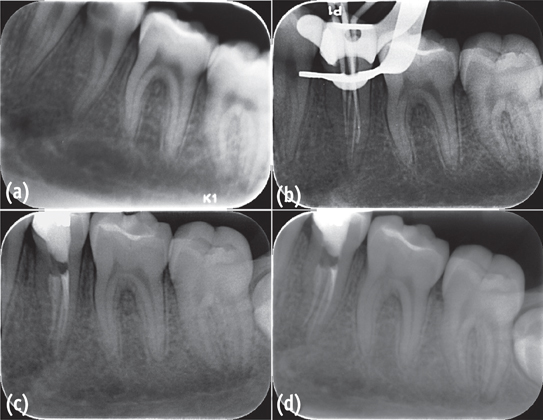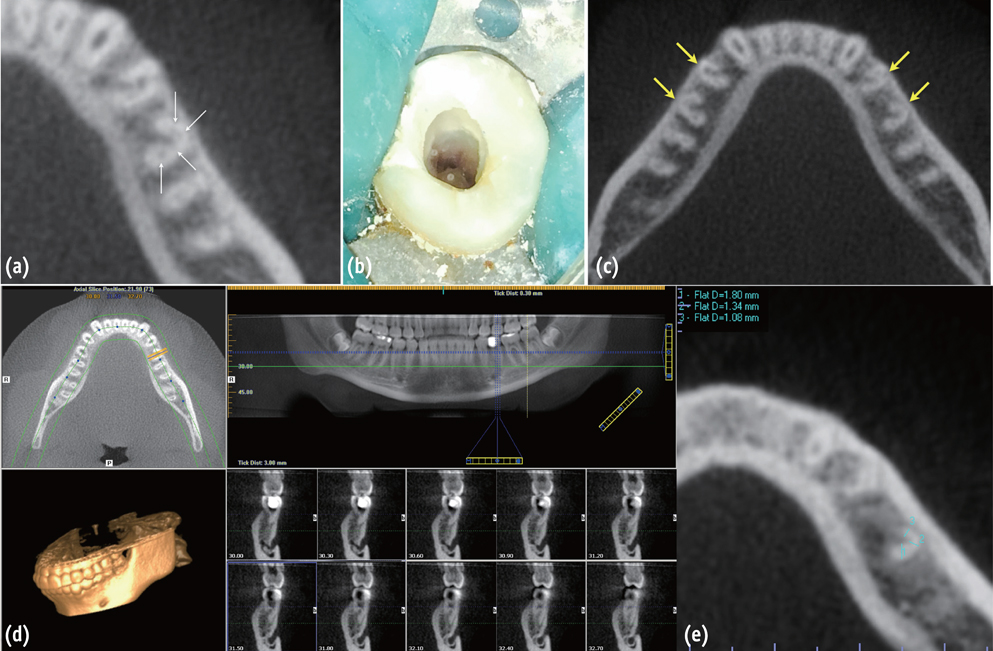Restor Dent Endod.
2016 Feb;41(1):68-73. 10.5395/rde.2016.41.1.68.
Endodontic treatment of a C-shaped mandibular second premolar with four root canals and three apical foramina: a case report
- Affiliations
-
- 1Division of Endodontics, Columbia University College of Dental Medicine, New York, NY, USA. sgk2114@columbia.edu
- KMID: 2316966
- DOI: http://doi.org/10.5395/rde.2016.41.1.68
Abstract
- This case report describes a unique C-shaped mandibular second premolar with four canals and three apical foramina and its endodontic management with the aid of cone-beam computer tomography (CBCT). C-shaped root canal morphology with four canals was identified under a dental operating microscope. A CBCT scan was taken to evaluate the aberrant root canal anatomy and devise a better instrumentation strategy based on the anatomy. All canals were instrumented to have a 0.05 taper using 1.0 mm step-back filing with appropriate apical sizes determined from the CBCT scan images and filled using a warm vertical compaction technique. A C-shaped mandibular second premolar with multiple canals is an anatomically rare case for clinicians, yet its endodontic treatment may require a careful instrumentation strategy due to the difficulty in disinfecting the canals in the thin root area without compromising the root structure.
Keyword
MeSH Terms
Figure
Reference
-
1. Pineda F, Kuttler Y. Mesiodistal and buccolingual roentgenographic investigation of 7,275 root canals. Oral Surg Oral Med Oral Pathol. 1972; 33:101–110.
Article2. Sert S, Bayirli GS. Evaluation of the root canal configurations of the mandibular and maxillary permanent teeth by gender in the Turkish population. J Endod. 2004; 30:391–398.
Article3. Awawdeh LA, Al-Qudah AA. Root form and canal morphology of mandibular premolars in a Jordanian population. Int Endod J. 2008; 41:240–248.
Article4. Zillich R, Dowson J. Root canal morphology of mandibular first and second premolars. Oral Surg Oral Med Oral Pathol. 1973; 36:738–744.
Article5. Holtzman L. Root canal treatment of mandibular second premolar with four root canals: a case report. Int Endod J. 1998; 31:364–366.
Article6. Bram SM, Fleisher R. Endodontic therapy in a mandibular second bicuspid with four canals. J Endod. 1991; 17:513–515.7. Rhodes JS. A case of unusual anatomy: a mandibular second premolar with four canals. Int Endod J. 2001; 34:645–648.
Article8. Macri E, Zmener O. Five canals in a mandibular second premolar. J Endod. 2000; 26:304–305.
Article9. Sachdeva GS, Ballal S, Gopikrishna V, Kandaswamy D. Endodontic management of a mandibular second premolar with four roots and four root canals with the aid of spiral computed tomography: a case report. J Endod. 2008; 34:104–107.
Article10. Yu X, Guo B, Li KZ, Zhang R, Tian YY, Wang H, Hu T. Cone-beam computed tomography study of root and canal morphology of mandibular premolars in a western Chinese population. BMC Med Imaging. 2012; 12:18.
Article11. Rahimi S, Shahi S, Yavari HR, Manafi H, Eskandarzadeh N. Root canal configuration of mandibular first and second premolars in an Iranian population. J Dent Res Dent Clin Dent Prospects. 2007; 1:59–64.12. Jafarzadeh H, Wu YN. The C-shaped root canal configuration: a review. J Endod. 2007; 33:517–523.
Article13. Lu TY, Yang SF, Pai SF. Complicated root canal morphology of mandibular first premolar in a Chinese population using the cross section method. J Endod. 2006; 32:932–936.
Article14. Sidow SJ, West LA, Liewehr FR, Loushine RJ. Root canal morphology of human maxillary and mandibular third molars. J Endod. 2000; 26:675–678.
Article15. Cleghorn BM, Christie WH, Dong CC. Root and root canal morphology of the human permanent maxillary first molar: a literature review. J Endod. 2006; 32:813–821.
Article16. Manning SA. Root canal anatomy of mandibular second molars. Part II. C-shaped canals. Int Endod J. 1990; 23:40–45.17. Barnett F. Mandibular molar with C-shaped canal. Endod Dent Traumatol. 1986; 2:79–81.
Article18. Varrela J. Effect of 45,X/46,XX mosaicism on root morphology of mandibular premolars. J Dent Res. 1992; 71:1604–1606.
Article19. Varrela J. Root morphology of mandibular premolars in human 45,X females. Arch Oral Biol. 1990; 35:109–112.
Article20. Kusiak A, Sadlak-Nowicka J, Limon J, Kochńska B. Root morphology of mandibular premolars in 40 patients with Turner syndrome. Int Endod J. 2005; 38:822–826.
Article21. Chauhan R, Singh S, Chandra A. A rare occurrence of bilateral C-shaped roots in mandibular first and second premolars diagnosed with the aid of spiral computed tomography. J Clin Exp Dent. 2014; 6:e440–e443.
Article22. Shah DY. C-shaped root canal configuration in mandibular second premolar: report of an unusual case and its endodontic management. J Int Clin Dent Res Organ. 2012; 4:18–20.
Article23. Hunter AJ, Feiglin B, Williams JF. Effects of post placement on endodontically treated teeth. J Prosthet Dent. 1989; 62:166–172.
Article24. Tilk MA, Lommel TJ, Gerstein H. A study of mandibular and maxillary root widths to determine dowel size. J Endod. 1979; 5:79–82.
Article25. Johnson JK, Schwartz NL, Blackwell RT. Evaluation and restoration of endodontically treated posterior teeth. J Am Dent Assoc. 1976; 93:597–605.
Article26. Lim SS, Stock CJ. The risk of perforation in the curved canal: anticurvature filing compared with the stepback technique. Int Endod J. 1987; 20:33–39.
Article27. Zuckerman O, Katz A, Pilo R, Tamse A, Fuss Z. Residual dentin thickness in mesial roots of mandibular molars prepared with Lightspeed rotary instruments and Gates-Glidden reamers. Oral Surg Oral Med Oral Pathol Oral Radiol Endod. 2003; 96:351–355.
Article28. Jerome CE. C-shaped root canal systems: diagnosis, treatment, and restoration. Gen Dent. 1994; 42:424–427.29. Cooke HG 3rd, Cox FL. C-shaped canal configurations in mandibular molars. J Am Dent Assoc. 1979; 99:836–839.
Article30. Haddad GY, Nehme WB, Ounsi HF. Diagnosis, classification, and frequency of C-shaped canals in mandibular second molars in the Lebanese population. J Endod. 1999; 25:268–271.
Article
- Full Text Links
- Actions
-
Cited
- CITED
-
- Close
- Share
- Similar articles
-
- Root canal treatment of a mandibular second premolar with three separate root canals
- Use of cone-beam computed tomography and three-dimensional modeling for assessment of anomalous pulp canal configuration: a case report
- Outcome Assessment of Endodontic Treatment of Mandibular Second Molars with C-shaped Canals in Elderly Patients
- A retrospective study on incidence of C-shaped canals in mandibular second molars
- Healing outcomes of root canal treatment for C-shaped mandibular second molars: a retrospective analysis



